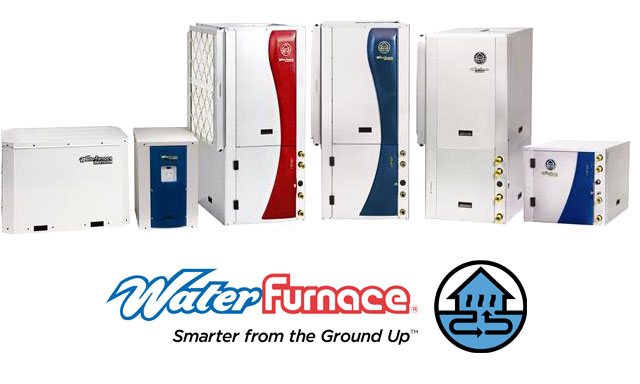.jpg)
Geothermal Systems in Bloomington, IN
Serving Monroe County • Ellettsville • Bedford • Martinsville • Spencer and surrounding areas
High-performance comfort that runs on the Earth’s constant temperature—not on natural gas or outdoor air.
What Makes a Ground Source Geothermal Heat Pump Different?
Most people hear “heat pump” and think of the unit sitting outside that freezes over in winter. That’s an air-source heat pump—it pulls heat from outdoor air, which becomes less efficient when temperatures drop.
A ground-source heat pump (GSHP) is entirely different. Instead of fighting fluctuating air temperatures, it draws energy from the Earth itself, where temperatures stay near 55°F year-round in southern Indiana. This steady environment lets the system deliver 3.5 to 5 times more heat energy than the electricity it consumes—a level of performance air-source systems simply can’t match.
How Ground Source Geothermal Systems Work
- Closed Ground Loop: A continuous circuit of high-density polyethylene piping is buried underground, filled with a water-based antifreeze solution.
- Heat Exchange: In winter, the fluid absorbs heat from the ground and carries it to the indoor unit.
- Compressor Stage: The geothermal heat pump compresses that energy to a higher temperature.
- Distribution: The conditioned air or hydronic water is circulated through ducts, radiant floors, or fan coils to heat the home.
- Cooling Mode: In summer, the process reverses—heat is drawn out of the home and sent back into the ground.
Unlike air-source units, there’s no outdoor condenser fighting weather extremes, frost, or defrost cycles. Everything critical sits safely indoors, quietly doing its job for decades.
Cost and Incentives (Accurate for 2025)
Typical range: $14,500–$38,000 for a residential installation in Monroe County. Cost depends on loop type (horizontal vs. vertical), bore depth, soil/rock makeup, and system size.
Federal Tax Credit: 30% available through December 31, 2025, after which it is scheduled to decrease unless renewed.
Local rebates: Some utilities, such as CenterPoint Energy and Duke Energy, periodically offer incentives for GSHP installations.
Operating cost: Roughly 30–50% lower annual energy use than a conventional furnace/air conditioner pair in southern Indiana’s climate.
Because the system runs entirely on electricity, it’s unaffected by natural gas price swings, pipeline capacity limits, or seasonal rate spikes.
Loop Configurations
- Horizontal Loop: Trenches 4–6 ft deep are dug in long runs. Ideal for new builds or large lots. Lowest installation cost per foot.
- Vertical Loop: Boreholes drilled 100–400 ft deep, each containing U-bend pipe pairs. Suited for smaller lots or rocky terrain.
- Pond/Lake Loop: Coils submerged in a nearby body of water, when available. Provides excellent thermal exchange with minimal excavation.
All three loop styles perform similarly once installed—the design choice depends on available land, geology, and cost efficiency.
Energy Use and Electrical Load
A typical 3-ton ground-source system in Bloomington uses roughly 2,500–3,000 kWh/year for heating and 1,500–2,000 kWh/year for cooling—about 40–50% less total electricity than a standard heat pump–AC combination. That makes it one of the few technologies that can cut total home energy use while running entirely on the grid.
Lifespan and Maintenance
- Ground loop: 25–50 years; requires little more than periodic pressure checks.
- Indoor heat pump unit: 20–25 years with annual servicing.
No combustion, no venting, no outdoor corrosion—just quiet, steady performance.
Environmental Advantage
Every GSHP installation taps a renewable, zero-emission energy source directly beneath the surface. For an average Monroe County home, switching from a gas furnace and AC to geothermal can reduce annual carbon emissions by 3–5 tons, depending on the electricity mix. As Indiana utilities continue integrating renewables, geothermal systems become even cleaner each year.
Frequently Asked Questions
Q: How is a ground-source heat pump different from an air-source
heat pump?
A: It transfers heat to and from the ground instead of outdoor air,
maintaining high efficiency even in freezing weather and eliminating outdoor units.
Q: What does a system cost in Bloomington, Indiana?
A: Most installations range from $14,500–$38,000, depending on loop
type, bore depth, and home size.
Q: How long do geothermal systems last?
A: The indoor heat pump averages 20–25 years; underground loops can
last 50 years or more.
Q: Are there tax credits or rebates?
A: Yes—a 30% federal tax credit applies through December 31, 2025.
Some utilities offer additional local rebates.
Q: How much energy does it save?
A: Typically 30–50% less total energy use than a furnace/AC system
and 40–50% less electricity than a conventional air-source heat pump.
Q: Does it rely on natural gas prices?
A: No. Ground-source systems operate on electricity only and are
fully independent of gas markets.
Why Choose Eco-Friendly Mechanical
- Certified geothermal and loop-design specialists
- Over 150 GSHP systems installed in Monroe County
- Detailed load calculations and soil assessments for every project
- All-inclusive pricing and paperwork for rebates/tax credits
- Full maintenance and repair support for the lifetime of the system
Ready to Upgrade?
Contact EcoFriendly Mechanical today for a ground-source geothermal system estimate in Bloomington, Indiana.
Enjoy long-term comfort, stable energy costs, and a system that’s as reliable as the ground beneath your feet.
